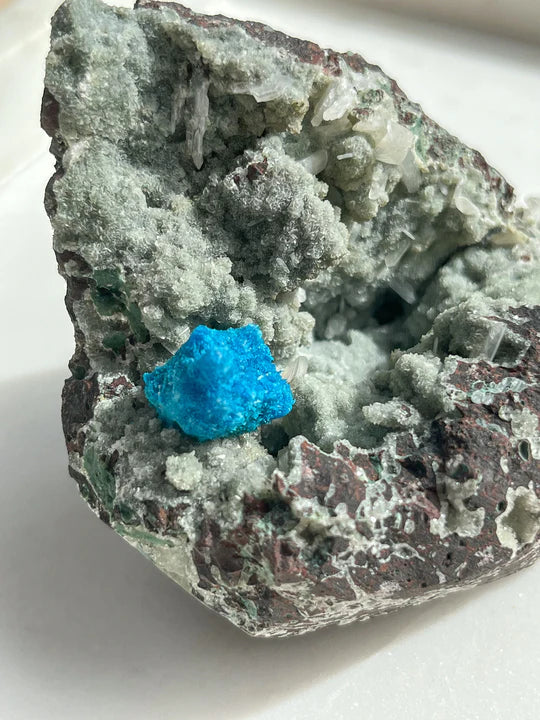
What is the Difference Between Cavansite and Pentagonite? An In-Depth Explanation
Share
What is Cavansite? What is Pentagonite?
Cavansite and Pentagonite are a small group of vanadium calcium phyllosilicate minerals that have distinctive ultramarine blue colouring. These specimens are predominately found in the Pune District and Deccan Traps of Maharashtra, India.
At the present time of writing this article, the Indian government has prohibited blasting in the basalt mines from which these specimens were mined and thus, is no longer allowing for excavation of minerals at present. Many specimens in circulation were being mined years prior to its closure.
This adds to their rarity & desirability amongst mineral collectors.
All of the Cavansite & Pentagonite specimens available at Priestess Crystals were mined in 2016, unless otherwise stated.
Why do they look so similar?
Whenever two minerals or two of anything in nature appear the same, it is because they have a similar chemical makeup. For example, both Cavansite and Pentagonite have a distinctive ultramarine-like blue colouration. However, upon closer inspection, we can see that their physical appearance varies quite significantly. Especially with exceptional specimens of Pentagonite (more on that below).
What is the difference between Cavansite and Pentagonite?
You can think of Pentagonite & Cavansite as non-identical twins (the technical term used to describe them is dimorph. So, Pentagonite & Cavansite can be regarded as dimorphs (ie non-identical matching twins) of each other). They look very similar and have a very similar chemical makeup, however, there are slight differences that we can see between the two.
These eye-catching blue specimens belong to the same crystal system (the orthorhombic system), however, their crystalline structures are not the same! To be even more precise, how the atoms connect together in 3-D space to form the final crystal, vary (diagram shown below).

Figure 1: Diagram of the b-axis view of Cavansite (Figure A) & Pentagonite (Figure B) structures. Even if you don't understand chemistry, you can visually see that the shape of the crystal structure and how the atoms connect in Cavansite and Pentagonite are different. Diagram obtained from Evans (1973).
Cavansite crystals form from spherulitic (sphere-like) rosette formations. They are usually seen as mini compact spheres with some small needle-like projections.
Cavansite is regarded as a low temperature form crystal (forms under lower temperatures)

PENTAGONITE FEATURES
Pentagonite is the rare dimorph of Cavansite. While Pentagonite specimens also exhibits spherulitic rose formations similar to Cavansite, they end in elongated acicular (needle-like) terminations.These terminations are up to 1cm, often more. Some have even been recorded to be 6-7cm long!
Pentagonite can also form structures known as “trees” or condensed “urchins” and "twins" (thin pairs of long, prismatic crystals - photo example below).

Exceptional example of the elongated, prismatic terminations of Pentagonite and twinning at the same time! Image credit: Kulin Pandey


Same, but different...
What makes them the same:
Cavansite and Pentagonite both have the same chemical composition & formula. Their vibrant ultramarine blue colour owes to the presence of vanadium in their chemical makeup.
They are both hydrous (have water in their chemical makeup) calcium vanadium phylosilicates found in association with basalt/andesitic rock & zeolites. They both occur as a secondary mineral formedafter processes such as weathering & erosion.
 What makes them different:
What makes them different:
From looking at their physical appearance, the differences are clear.
Colour: Cavansite crystals demonstrate a bright teal-blue colouration while Pentagonite crystals exhibit a deeper ultramarine blue colour.
Shape: Cavansite tends to exhibit small rose-like formations known as spherulitic rosettes, that have short, blunt terminations. On the other hand, Pentagonite exhibits prismatic, elongated terminations that extend from the spherulitic rosettes that can reach up to 6-7 centimetres in length. They are also capable of a crystal habit known as twinning, whereas Cavansite does not exhibit this.
Rarity: Cavansite and Pentagonite can both be regarded as rare minerals, However, Pentagonite crystal formations are scarcer than Cavansite and do not grow in great abundance.
To summarise:
Cavansite and Pentagonite are calcium vanadium phyllosilicates part of the orthorhombic crystal system. Pentagonite is the rare dimorph of Cavansite however, both of these mineral specimens are relatively rare and found almost exclusively within one location in the world. There are slight physical differences we observe between Cavansite & Pentagonite and these differences are due to slight variations we see in their chemical makeup. This is the basis of all chemistry: chemical differences lead to variations in physical appearance.
Now you know a little bit more about this rare mineral species!
References:
Evans, H, "The Crystal Structures of Cavansite and Pentagonite", American Minerologist, vol. 58, pp 412-424.
Website: Mindat.org


